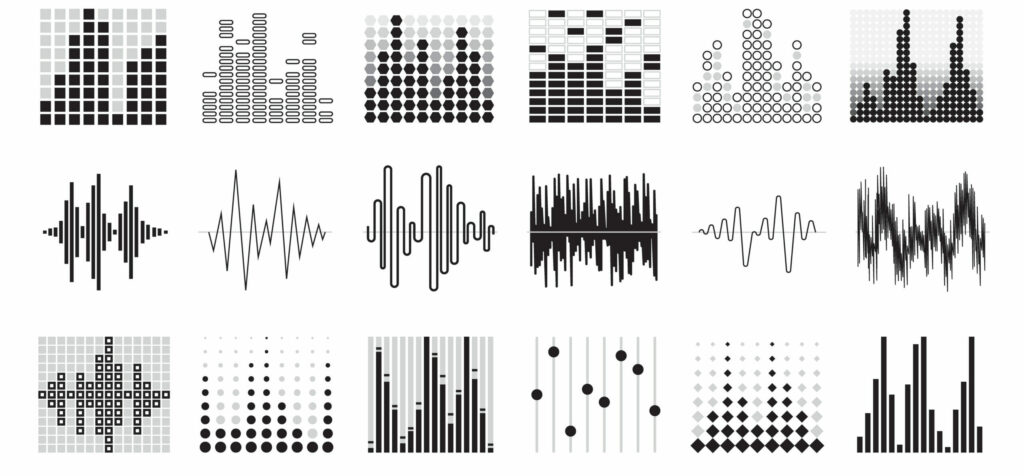Do you think you know a thing or two about acoustics? Whether you are a seasoned expert or a newcomer to the world of acoustics, this glossary offers something for everyone. In this article, we explain the most important sound and acoustic terms so you won’t get lost in the jargon.
We divided the glossary into sections to make it more digestible and easier to navigate. Additionally, you can skip to specific sections by following the links below in the table of contents. Furthermore, you can also click “ctrl+f” (PC) or “cmd+f” (Mac) to search for particular words.
If you’d like to explore similar audio terms, feel free to check out our other glossary articles. There, we explain every term on audio effects, mixing and mastering, and audio recording.
Table of Contents
- Acoustic Treatment
- Technical Acoustic Terms
- Acoustic Measurements
- Acoustic Phenomena
- Descriptive Acoustic Terms
- Conclusion: Sound & Acoustic Terms
Acoustic Treatment
This process improves the acoustic quality of a room for recording or mixing by using acoustic materials that absorb or diffuse sound waves.

Acoustic panel – Acoustic panels deal with a broad frequency range, typically handling the frequencies that the bass traps don’t address (mid/high frequencies).
Bass trap – Bass traps primarily absorb low frequencies.
Ceiling cloud – An acoustical panel suspended from the ceiling in a horizontal position.
Diffuser/Deflector panel – Diffusers are a type of acoustic treatment that scatters or diffuses reflections rather than absorbing them. This allows you to control room reflections without removing them completely. However, they are typically more expensive.
Fiberglass insulation – Fiberglass insulation absorbs sound in the same manner as bass traps, acoustic panels, and ceiling clouds. Nevertheless, they’re made from a different material, making them ideal for broadband bass traps.
Helmholtz resonator – A reactive, tuned sound absorber, it is essentially a hollow sphere with a small opening. For instance, examples of Helmholtz resonators include acoustic guitars and violins. Although not as common as a means of general acoustic treatment, they are still useful.
LEDE (Live-end-dead-end) – LEDE refers to a particular acoustic design for rooms where one end is highly absorbent, while the other end is reflective.
Monitor isolation pad – Pads that help reduce vibrations generated by studio monitors.
Vocal reflection filter – Vocal reflection filters help absorb sound waves that would otherwise reflect and hit the rear of a microphone.
Technical Acoustic Terms
Acoustics – The sound characteristics of a room.
Airborne noise – Unlike impact noise, airborne noise is sound transmitted by air.
Ambience – The residual room sound of a listening environment.
Anechoic – Anechoic simply means echo-free, i.e., little to no sound reflects off a surface.

Break – A physical gap in construction that acts to decouple sound vibrations from traveling through.
Coloration – This sound term refers to the timbre of a musical sound.
Dead – A spot or room is referred to as ‘dead’ when there is little or no reverberation and strong attenuation of high frequencies.
Direct sound – Sound coming directly from the source, rather than from reflections.
Flanking – This acoustical term refers to any non-direct path of sound transfer, moving room to room and traveling over or around a soundproof element. Many building elements can result in flanking, such as windows and doors.
Fundamental – The basic pitch of a musical note.
Impact noise – Unlike airborne noise, impact noise occurs when the vibration of a sound travels through a medium other than air, such as the structure of a room. An example would be foot thumps.

Impulse – This sound term refers to a very short, transient acoustical (or electrical) signal.
Isolation/Decoupling – Acoustic isolation is the process of separating assembly materials to stop the transfer of sound energy from one environment to another.
Node (dead spot) – A point or line where minimal air motion takes place.
Noise – Noise is any unwanted background sound.
Polarity – This is the direction of the waveform. If you “flip the polarity,” it turns the waveform upside down. Essentially, the positive excursions become negative, and the negative excursions become positive.
Polar plot – This is the graphic representation of diffusion or scattering over all incident angles at a rated frequency.
Psychoacoustics – The study of the perception of sound.
Threshold of hearing – The hearing threshold describes the sound level below which a human ear is unable to detect any sound. 0 dB is the reference level for adults.
Threshold of pain – The sound level at which people actually feel pain (around 140 dB).
Timbre – This sound term refers to the subjective tonal quality of a sound.
VU – A visual meter indicating the RMS value of a signal.
Acoustic Measurements
An acoustic measurement is any measurement that concerns acoustics.

Absorption coefficient – The ratio of sound absorption effectiveness.
A-Weighted sound level – A measure of sound pressure level designed to match the response of the human ear.
Critical distance – The distance between the sound source and microphone at which the reverberant sound level and the direct signal level are equal.
Cycle – This acoustical term refers to one complete vibration (a positive and negative movement of a vibration), with the base unit of Hertz being one cycle per second.
Decay time – The length of time taken for an audio signal to drop in amplitude to a specific portion of its initial value.
Hertz – The measuring unit of frequency or the speed of vibration of a sound wave. Synonymous with “cycles per second.”
Initial time-delay gap (signal delay) – The time interval that occurs between the arrival of a direct sound and the first reflection from the surfaces of the room.
Intensity – Intensity (or sound intensity/acoustic intensity) is the amount of sound energy radiated per unit area, measured in watts per square centimeter.
Level – Sound level is the intensity of sound measured with a sound level meter.
Power – Sound power is the total sound energy radiated by a source per unit of time.
Signal-to-noise ratio – This ratio compares the level of signal power to the noise power, often expressed in decibels.
Sound pressure – This sound term measures the pressure level of a sound, in dB.
Sound transmission loss – A measurement of the reduction in sound level of an audio source as it passes through an acoustic barrier; it measures the effectiveness of acoustic treatment.
Acoustic Phenomena
Acoustic phenomena refer to the occurrences, outcomes, and effects produced by acoustics.

Phase Phenomena
Phase describes the time relationship between two signals. More specifically, it explores the timing of a waveform’s positive and negative values in relation to the amplitude of frequencies.
Constructive interference – opposite of destructive interference. Constructive interference occurs when two waveforms of a similar phase line up, resulting in a wave with twice the amplitude of the original.
Destructive interference – The opposite of constructive interference. Destructive interference occurs when two similar waveforms come together in such a way that their crests do not line up, resulting in a reduction in amplitude or a complete cancellation.
In phase – Two periodic waves reaching peaks and going through zero at the same instant are said to be “in phase.”
Out of phase – Unlike in phase, out of phase refers to two related signals offset in time.
Phase cancellation – This sound term describes a phenomenon where two or more out-of-phase sound waves conflict and work against each other, sometimes canceling each other out.
Phase interference – The addition and/or subtraction of two waves of similar or multiple frequencies, causing peaks and dips in the overall response curve.
Room Acoustic Phenomena
These are a collection of acoustic effects that can occur within a room.
Absorption – Absorption is the process by which sound-absorbing material takes in the energy of a sound wave rather than reflecting it.
Comb filtering – Comb filtering happens when similar or identical sound waves reflect off hard surfaces and combine, often producing destructive interference. This process creates a series of peaks and troughs in the frequency response, resembling the teeth of a comb.
Damping – Damping reduces acoustic vibration within any type of structure, wall, or system by absorption or diffusion.
Decoupling – See isolation.
Diffraction – is the phenomenon of sound waves bending around obstacles.
Diffusion – Diffusion is the scattering of sound waves in a given environment.
Early reflection – Early reflections are the slight reflections that arrive after the direct sound but before the onset of full reverberation.

Flutter echo – This sound term refers to a repetitive echo set up by parallel reflecting surfaces.
Late reflection – Unlike early reflections, late reflections are those distinguishable from direct signals.
Noise Floor – The noise floor is the base-level noise occurring in your recording, whether it’s coming from your devices or other noises.
Phase Cancellation – See phase cancellation.
Plosives – Plosives are distortions caused by strong blasts of air that result from certain consonant sounds from a singer hitting the microphone.
Proximity effect – The proximity effect is the exaggeration of the low-end when a directional microphone is located very near the sound source.
Rarefaction – Unlike compression, rarefaction is the decrease in density and pressure in a medium, such as air, caused by the passage of a sound wave.
Refraction – Refraction is the bending of sound waves traveling through layered media with different sound velocities.
Reflection – Reflection is the process by which materials reflect the energy of a sound wave rather than absorbing it.
Resonance – Resonance occurs when a system vibrates at a certain frequency.
Reverberation – Reverberation, or reverb, occurs when a sound hits a surface (or various surfaces) and reflects back at varying times and amplitudes, creating a complex echo.
Room modes – See room modes.
Sibilance – Harsh hissing and whistling sounds produced by certain consonants such as ‘s’, ‘c’, ‘t’, and ‘z’. You can reduce this effect with a de-esser.
Specular reflection – Specular reflection, or regular reflection, is a mirror-like reflection.
Room Modes
Room modes are the collections of resonant frequencies that occur within a room. They occur when certain wavelengths of specific audio frequencies correlate to the fundamental resonances of a room. They can distort the acoustics of a room, especially in the low-frequency range.

Axial mode – Axial mode is the most dominant type of room mode. Resonances occur between a pair of parallel surfaces in a room, such as the front and back walls.
Tangential mode – Tangential modes occur between two pairs of parallel surfaces in a room, such as the front/rear and side walls, and measure half the intensity of axial modes.
Oblique mode – Oblique modes are a quarter of the intensity of axial modes. Resonances occur between three pairs of parallel surfaces in a room, such as front/rear, sides, and ceiling/floor.
General Acoustic Phenomena
These are a collection of general acoustic phenomena that don’t necessarily occur within a room.
Doppler effect – The Doppler effect describes how moving sound sources or observers change frequencies.
Fletcher-Munson curves / equal loudness contours – Equal loudness contours illustrate how human listeners perceive the apparent loudness of sound in relation to its frequency.
Front-to-back imaging – This term refers to placing vocal or musical information closer to or farther from the center position, front-to-back.
Haas effect – When one sound follows another with a delay of around 40 ms or less (below the human echo threshold), listeners perceive the two as a single sound.
Leakage (sound bleed) – This sound term describes the amount of sound that listeners hear outside the intended area. It commonly refers to sound that escapes headphones.
Masking (or collisions) – Masking occurs when distinguishing between two sounds becomes difficult because they exist in the same frequency range. You typically want to avoid these collisions so that your instruments can sit well in the mix.

Rumble – Rumble is a low-frequency vibration.
Standing wave – Standing waves are the combination of two waves moving in opposite directions, continuously reinforced by their own reflections.
Descriptive Acoustic Terms
Descriptive acoustic terms are the vocabulary used to describe a sound’s acoustic properties.
Boomy – Excessive low-end.
Boxy – The opposite of thin. Full and warm with a particular emphasis on the upper bass.
Bright – Excessive high-end.
Clean – Lack of distortion and an accurate input-to-output relationship.
Crunchy – This sound term refers to a rough and distorted sound.
Dark – The opposite of bright. Lacks high-end over around 5 kHz. Fewer higher frequencies.
Deep – This acoustical term refers to both an extended frequency response and a complex reverb.
Dry/Wet – Dry and wet refer to whether a sound is processed. Dry is unprocessed, and wet is processed.
Dynamic – Changes in volume create energy and excitement.
Flat – This acoustic term describes an even frequency response where no frequency is accentuated.
Harsh – An overabundance of upper midrange creates peaks between 2 and 6 kHz, resulting in a grating, abrasive, and painful listening experience.
Hiss – This term identifies a harsh and piercing high frequency.
Muddy – Muddy means it’s not clear. Too much in the 180 Hz-300 Hz area. Uncontrolled low end.
Subbiness – Subbiness is the exaggeration of low audio frequencies between 20 Hz and 60 Hz.
Warm – This acoustical term means full-bodied, spacious, rich, and round sound. Good bass and adequate low frequencies. Not thin.
Wide – A sound is wide if it occupies a lot of the stereo field.

Conclusion: Sound & Acoustic Terms
If you’ve made it this far, you can consider yourself an acoustics expert. Whether you read every single term or not, be sure to bookmark this page to use it as a reference when you encounter an unfamiliar acoustics term.
If you want to learn more about mixing and mastering, then head over to our blog, or alternatively, sign up for our newsletter by creating a MasteringBOX account. Thanks for reading, and happy mixing!
About the Author

Joe Curtis
Digital Marketer and Content WriterJoe Curtis is a passioned Digital Marketer from the UK. In his time on MasteringBOX he has created amazing content about Audio and Music Production.
Leave a comment
Log in to comment


